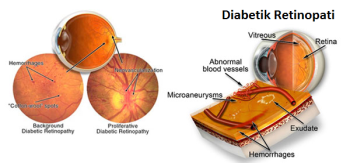
The retina is a thin tissue covering the interior surface of the eyeball.
It involved visual cells and visual nerve fibres.
• Retinal decollement (retinal detachment):
It is the case where the retina is detached from the eye wall to which it is normally attached.
It is a dangerous eye disease.
The sudden blackness emerging in the edge of the visual quadrant and floaters appearing (flying ashes) may be the symptoms of the retinal decollement.
The risk of decollement is higher in myopias higher than the number 6 (dioptri) and after cataract surgeries.
This problem displaying itself with flashes of lightning in eyes may lead to complete loss of vision.
The treatment in the early phase may be performed with argon laser.
In the advanced phase the surgical treatment is required.
• Diabetic retinopathy:
They are the problems caused by diabetes in the retina.
Its primary treatment is performed with the argon laser application.
When triamcinolone is injected into the eye, though temporarily, the problems come to an end.
In advanced cases, vitreous-retinal surgeries (VRC) are required.
Patients with diabetes should have a retina examination once every 6 months.
• Macular Degeneration
It is the decrease in sight upon the fact that the yellow spot loses its function in advanced ages.
There are two types of degenerations: Dry and wet types.
In the dry type, capillaries are healthy and there is no bleeding; the sight decreases, but blindness does not emerge.
In macular degeneration, the central visual area gets black and cannot be seen. The surrounding visual area can be seen.
In the wet-type, the risk of blindness is available.
In treatment of wet-type macular degeneration, argon laser, intraocular injections and photodynamic therapies are used.
The injections may be required to be applied in many times.
Patients should have an examination once every 4 months.
Patients with lower vision can see the near with the LVA (Low Vision Aids).
• Retinal Vascular Occlusions:
In the retina, there may be vein or artery occlusions.
Vein occlusions are more frequently seen in people over 50 with atherosclerosis or hypertension.
Artery occlusions are more frequently seen in people with a high degree of cholesterol or blood clots in the heart.
In the artery occlusions, there is the appearance of a "red stain in the middle of a white background" and this appearance is referred as the finding of Japanese flag.
In the vein occlusions the treatment is performed with the argon laser application and/or intraocular cortisone injections.
In the artery occlusions the treatment is URGENT!
The artery occlusions that cannot be resolved within 48 hours, it is the cause of permanent loss of vision.
In the artery occlusions, massages should be applied on the eyeball with strong pressures and medications decreasing the intraocular pressure should be given and in treatment of divers crippled by the bends the hyperbaric oxygen application used should be tried.
People having suffered from artery occlusions are susceptible to heart attacks and strokes; therefore, they should be examined by cardiologists and neurologists.